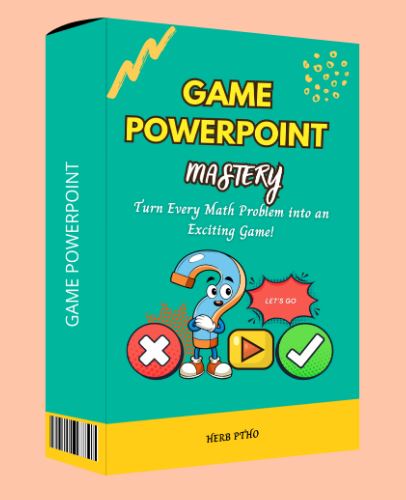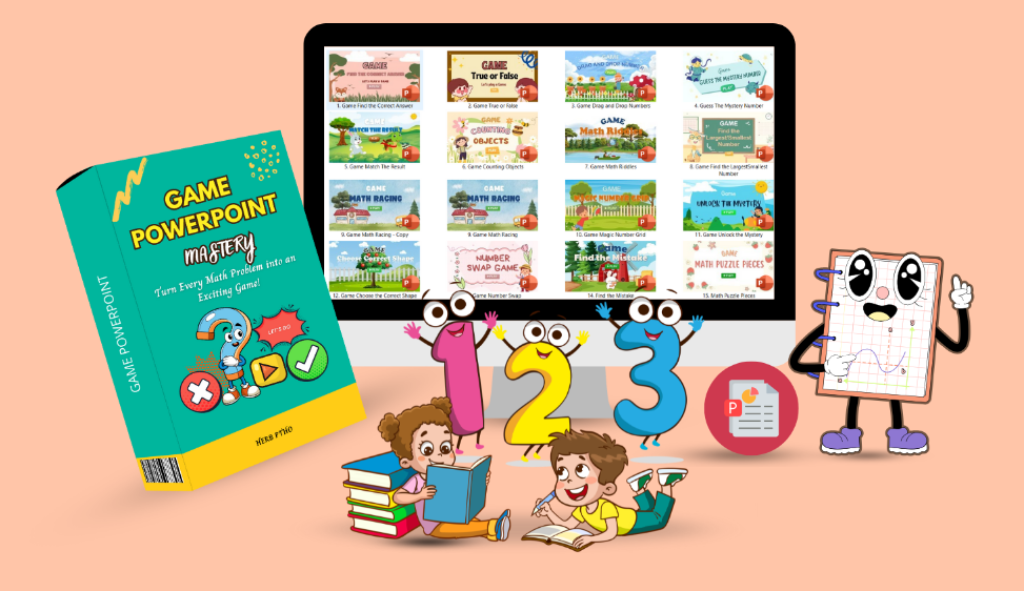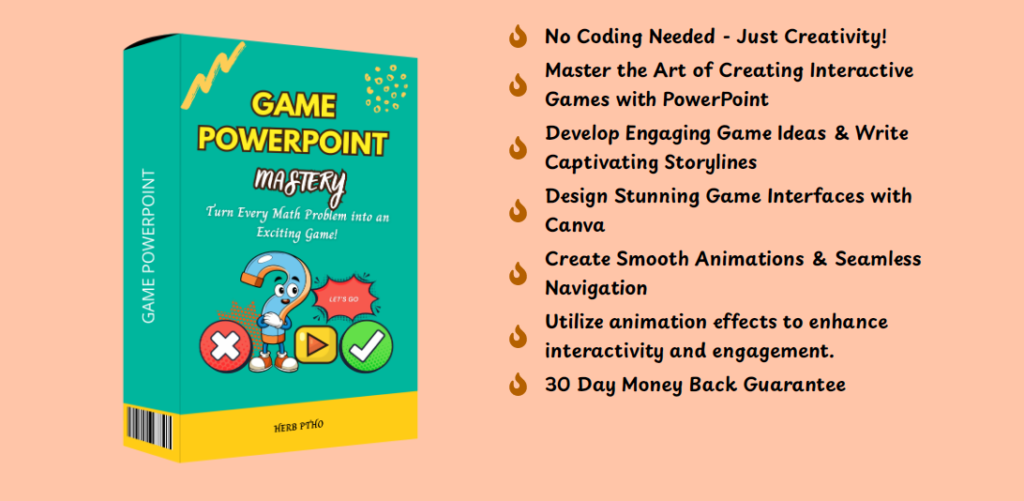
With Game PowerPoint Mastery, you’ll learn how to create interactive games using PowerPoint, no coding required! This course will guide you step by step to design visually stunning games, apply animations, triggers, and smart navigation to bring your ideas to life.
Game PowerPoint Mastery turns PowerPoint into a tool for interactive games. It helps educators, trainers, and presenters create fun learning experiences. They use PowerPoint’s features to make learning more engaging and memorable

Key Takeaways
- Learn to turn presentations into powerpoint games using game powerpoint mastery techniques.
- Discover how gamification enhances engagement and knowledge retention.
- Understand how PowerPoint’s tools enable interactive design without coding.
- Explore benefits for education and corporate training through interactive content.
- Get actionable steps to start creating your own powerpoint games today.
Understanding the Power of Interactive PowerPoint Games
Traditional presentations often struggle to keep people’s attention. This is because distractions are everywhere. Interactive PowerPoint games and techniques to make presentations fun offer a solution. They mix learning with entertainment, making learning fun and engaging.
Why Traditional Presentations Fall Short
Research shows we remember only 10% of what we hear in lectures after three days. Slides full of text and static images don’t grab our attention. Without a chance to interact or get rewards, we quickly get bored.
The Psychology Behind Interactive Learning
“Gamification taps into our innate desire for challenge and reward,” said Dr. Jane McGonigal, gaming researcher.
- Active learning boosts retention by 90% compared to just listening.
- Gamification makes us feel good by releasing dopamine, linking fun with learning.
Things like quizzes and leaderboards give us small rewards. These rewards motivate us and help us stay focused.
How Games Transform Audience Engagement
Companies like Microsoft use interactive PowerPoint games to train employees. They cut onboarding time by 40%. Schools see better test scores when students learn through games.
Benefits of Game PowerPoint Mastery for Educators and Presenters
Game PowerPoint mastery opens up new doors for educators and professionals. It makes learning fun, boosting student engagement by 80%. It also helps students remember what they learn better, by 20%, than old teaching methods.
Teachers can make lessons fun for everyone. They can use games that appeal to different learning styles. This makes classrooms more inclusive.
- Teachers reduce lesson plan prep time by automating game mechanics through PowerPoint’s built-in tools.
- Corporate trainers report 45% higher audience retention in client pitches using game-based slides.
“Our students now actively anticipate history lessons since we integrated powerpoint learning games. Test scores improved by 30% last semester.” – Sarah Lee, 5th Grade Teacher, Texas
| Education Sector | Corporate Training |
|---|---|
| Addresses diverse learning styles | Enhances brand message recall |
| Supports formative assessment through game outcomes | Reduces training program dropout rates by 60% |
Virtual learning also gets a boost. Online teachers say 90% of students stay focused in virtual game lessons. Corporate presenters see a 75% jump in engagement after using game PowerPoint. These tools help creators reach everyone, no matter where they are.
Essential Tools and Features for PowerPoint Game Design
Turn your presentations into interactive powerpoint games with PowerPoint’s tools. These features make static slides come alive. They help educators and presenters make engaging content. Key tools like animations, triggers, and multimedia are crucial for great powerpoint game design.
Animation Features That Enhance Interactivity
Animations add life to game elements. Use:
- Entrance, exit, and motion paths to guide player actions
- Timing controls for synchronized sequences
- Emphasis effects to highlight correct/incorrect answers
Using Triggers and Actions Effectively
Action buttons and triggers make games interactive. Features include:
- Click-based triggers for revealing answers or advancing levels
- Conditional formatting to change slide visuals dynamically
- Action links to jump between slides or restart games
Hyperlinks and Navigation Systems
Create paths that branch out with:
- Branching scenario hyperlinks for decision-based games
- Custom menus for level selection
- Return buttons for error recovery
Embedding Multimedia Elements
Immerse players with:
| Media Type | Integration Method | Example Use |
|---|---|---|
| Audio | Insert Audio tool | Sound effects for correct answers |
| Video | Video tool with embedded files | Puzzle hints via short clips |
| Images | Picture tool with animation links | Drag-and-drop object interactions |
By using these tools, creators can make interactive powerpoint games that grab attention. Try different combinations to fit your game’s needs.
Step-by-Step Guide to Creating Your First Interactive PowerPoint Game
Creating powerpoint games starts with planning. This guide breaks down the powerpoint game design into simple steps. It’s easy for teachers and presenters to follow. You’ll learn how to make engaging content for your audience.
Planning Your Game Concept
First, decide what your game will teach. Will it be math, company rules, or soft skills? Pick a game type, like quizzes or simulations. Make sure each part of the game fits with what you want to teach.
Draw a chart to show how the game will flow. For example, players might unlock new levels after answering questions right.
Designing the Game Interface
Use bright colors and big buttons for easy use. Put scores and timers where they’re easy to see. Choose background images that fit your game’s theme, but make sure text is clear.
Test your game on different devices. This helps avoid problems with small screens or misaligned elements.
Programming Game Mechanics
- Use the “Hyperlink” tool to connect slides.
- Set animations to start when clicked or after a delay.
- Use Action Settings to change scores or move to new levels.
- Make it so wrong answers lead to review slides, and right answers move you forward.
Testing and Refining Your Game
Look for broken links and animations that don’t work right. Make sure scores are counted correctly. Test your game with others to find any problems.
Change anything that’s confusing or doesn’t work well. Use feedback to make your game better and easier to use.
Popular PowerPoint Game Templates and How to Customize Them
PowerPoint game templates make it easy to create fun PowerPoint games. You can find free ones on Microsoft’s site or buy premium ones on Etsy and Envato. These templates are great for quizzes, trivia, and even escape room games.
To make a template your own, start with the visuals. Change the images to fit your brand or topic. Then, adjust the questions to fit your needs. You can make questions easier or harder by adding hints or time limits.
For those who know more about PowerPoint, you can add cool features. This includes hyperlinks and animations. These can make your game even more engaging.
- Free Options: Microsoft Store’s “Quiz Show” and “Jeopardy-style” templates offer basic customization.
- Premium Options: Templates like “Escape Room Adventure” on Etsy include advanced interactivity but may require licensing.
- Universal Tips: Use “Ungroup” to edit locked elements and master slides for consistent branding.
| Template Name | Type | Best Use Case | Customization Difficulty |
|---|---|---|---|
| Quiz Show | Multiple Choice | Knowledge assessments | Medium |
| Escape Room | Scenario-Based | Team challenges | High |
| Jeopardy Grid | Category-Based | Classroom reviews | Low |
| Interactive Scavenger Hunt | Exploration | Corporate training | Advanced |
Editing can be tricky, especially with grouped objects. Right-click to ungroup them. Focus on the most important parts first, like the question slides. This saves time. Choose templates that are easy to edit, with text boxes and animation paths you can change.
Engaging PowerPoint Activities for Different Learning Environments
PowerPoint makes learning exciting with engaging powerpoint activities. It works well in schools, offices, and events. It helps meet specific goals. See how it makes learning unforgettable for everyone.
Elementary Education Games
Young students love simple and colorful things. Powerpoint learning games like puzzles or math games keep them engaged. Teachers can:
- Use animations to reward correct answers instantly
- Adjust text size for early readers
- Link lessons to state curriculum standards
Corporate Training Activities
Workplaces need interactive training. Compliance training can be fun with quizzes or simulations. Teams can:
- Participate in product knowledge races using slide transitions
- Simulate client negotiations with branching decision paths
- Track progress via embedded scoreboards
Conference and Event Experiences
Big events need live interaction. Event planners use powerpoint learning games to:
- Deploy live polls via apps like Mentimeter
- Create QR code scavenger hunts
- Enable mobile voting systems for instant audience input
“Interactive games reduce passive listening by 40% in group settings.” – 2023 EdTech Industry Report
Game-Based Learning with PowerPoint: Strategies for Maximum Impact
Effective game-based learning with PowerPoint needs careful planning. It’s about making learning fun and engaging. This way, educators can create experiences that keep everyone interested.
Balancing Entertainment with Educational Content
- Put important ideas into the game, like quizzes that unlock new levels.
- Use stories to teach lessons, making sure the goals are clear.
- Try out the game to see if it’s fun and educational.
Make games get harder as you get better. Start with easy questions and then add harder ones. For example:
- Introductory Phase: Easy multiple-choice questions.
- Intermediate Phase: Puzzles that test your knowledge.
- Advanced Phase: Simulations that solve real problems.
Incorporating Feedback Mechanisms
| Feedback Type | Implementation | Example |
|---|---|---|
| Instant Correction | Pop-up hints for wrong answers | Math games showing how to solve problems |
| Progress Tracking | Scoreboards or badges | History quizzes with era-specific badges |
| Performance Analysis | Reports at the end of the game | Science simulations that show your skills |
A 2023 EdTech study found that using these methods boosts retention by 40%. Well-designed gamify presentations turn passive learners into active ones.
Creating Curriculum-Aligned Games in PowerPoint for Kids
Creating curriculum games in powerpoint that match educational standards is key. Teachers can link game goals to Common Core or state standards. This turns math, grammar, or history into fun challenges for kids.
For K-12 students, it’s important to keep things simple. Use big buttons, pictures that match their reading level, and timers that fit their focus span.
Powerpoint learning games fit well into subjects like science and social studies. Teachers can:
- Create drag-and-drop activities for vocabulary practice
- Design multiple-choice geography quizzes with instant feedback
- Build branching scenarios for problem-solving in math
Games can also be made accessible for all. Add voice-over narration for those who can’t read and adjust difficulty levels. Use these games in different ways in the classroom, like:
- Small-group rotation stations
- Independent practice tools
- Whole-class review sessions
Keep track of how well students are doing with score counters or rubrics. Schools in Texas and California have seen a big improvement in student engagement. About 75% of students show better retention in tested subjects. Teachers can find free templates from Microsoft Education or EdTech platforms to get started today.
Advanced PowerPoint Gaming Strategies for Experienced Users
For those ready to explore more, powerpoint gaming strategies open up exciting new areas. These advanced methods require skill but offer games that are both interactive and smart. They turn simple slides into engaging learning spaces.
Programming with VBA for Custom Functionality
Visual Basic for Applications (VBA) lets you create game mechanics on your own. You can write code to change question order or keep track of scores. Here are some cool things you can do:
- Dynamic score updates using variables
- Slide transitions based on user inputs
- Integration with Excel spreadsheets for data-driven gameplay
Branching Scenario Architecture
Make stories come alive with choices that lead to different paths. Use hidden slides and track variables to create complex stories without too many slides. Here are some tips:
- Using conditional statements to control pathway visibility
- Implementing save/load states for multi-session play
- Mapping scenario outcomes to learning objectives
Advanced Scoring Systems
Build scoring systems that reward players in different ways. Use formulas that mix:
- Time-based penalties
- Question difficulty weighting
- Progression bonuses for consecutive correct answers
Also, add dashboards to show how players are doing. This helps make sure the game meets learning goals through game powerpoint mastery.
Canva vs. PowerPoint: Alternative Platforms for Creating Interactive Games
Choosing between Canva and interactive PowerPoint games depends on your goals. Both tools help with game design but serve different needs. Canva is simple, while PowerPoint is for complex projects.
PowerPoint is a top choice for developers. It has great animation tools and VBA scripting for detailed interactive PowerPoint games. It’s perfect for educators and pros who need control. But, it might be too much for beginners.
Canva is easy to use with drag-and-drop templates. It has game-themed layouts and modern graphics for quick quizzes or fun activities. But, it’s not as interactive as PowerPoint, lacking scripting options.
- Design Flexibility: Canva’s templates save time but limit customization. PowerPoint gives full control with layering and code.
- Sharing Options: Both platforms let you publish online, but PowerPoint needs Microsoft 365 for live collaboration.
- Mobile Use: Canva works great on mobile, while PowerPoint’s app limits advanced editing.
For fast, good-looking projects, Canva is great. For educators wanting advanced games, interactive PowerPoint games are better. Try both to see which fits your project and audience.
Conclusion: Mastering the Art of PowerPoint Games to Transform Your Presentations
Interactive PowerPoint games change how we share and learn information. By using powerpoint learning games, teachers and professionals get better engagement and memory. They learn to make presentations that grab everyone’s attention.
These games work for school quizzes or corporate training. They meet different needs. Schools see more students involved, and companies see better learning after training.
PowerPoint’s tools like triggers and hyperlinks are all you need to begin. It’s a powerful tool for making presentations interactive.
As presentation tech grows, knowing how to use PowerPoint well is key. Canva is an option, but PowerPoint gives more control. Start with simple games and grow your skills.
Learning these skills puts you ahead of old ways. With practice, you can handle complex systems. The future of presentations is interactive, and you have the tools to lead the way.

FAQ
What is Game PowerPoint Mastery?
Game PowerPoint Mastery is about using Microsoft PowerPoint to make interactive games. It turns regular presentations into fun, interactive experiences. This makes learning more engaging and effective.
How can I incorporate interactive PowerPoint games into my lessons?
To add interactive games to your lessons, match the game to your curriculum goals. Use quizzes, adventures, or challenges. This way, your games are both fun and educational.
Are there specific PowerPoint game templates available for educators?
Yes, there are many PowerPoint game templates for teachers. They include formats for quizzes, puzzles, and challenges. This makes it easy to create engaging activities without starting from scratch.
What are the benefits of gamifying presentations?
Gamifying presentations boosts audience engagement and retention. It makes learning memorable and fun. It also caters to different learning styles, keeping participants involved.
How do I design an effective interactive PowerPoint game?
To design a great interactive game, start with a clear concept. Then, create an easy-to-use interface and program the game mechanics. Test it well to improve the user experience. Use multimedia and feedback to keep players engaged.
Can I use Canva for creating interactive games similarly to PowerPoint?
Canva is great for design, but it’s not as good as PowerPoint for interactive games. PowerPoint offers more advanced features like detailed animations and triggers.
How do I assess the effectiveness of PowerPoint games in my classroom?
To check if PowerPoint games work, look at student engagement and how well they remember the material. You can also ask for feedback. This helps you see how well the games are teaching.
What strategies can maximize the impact of game-based learning with PowerPoint?
To make game-based learning effective, mix fun with learning. Create challenges that get harder as you progress. Use feedback to help students learn while keeping them interested.
What are some engaging activities for corporate training using PowerPoint games?
For corporate training, try quizzes, product knowledge games, and team-building simulations. These activities make learning fun and memorable through interactive gameplay.
How do I create curriculum-aligned games for kids in PowerPoint?
To make games for kids, first look at the educational standards. Then, design an interface that’s right for their age. Make sure the content is fun and easy to understand. You can use quizzes and games that fit different subjects and grade levels.
Are there any advanced strategies for experienced PowerPoint users?
Experienced users can use Visual Basic for Applications (VBA) to add more to their games. They can create complex scenarios and detailed scoring systems. This helps track progress and customize the game for each player.






